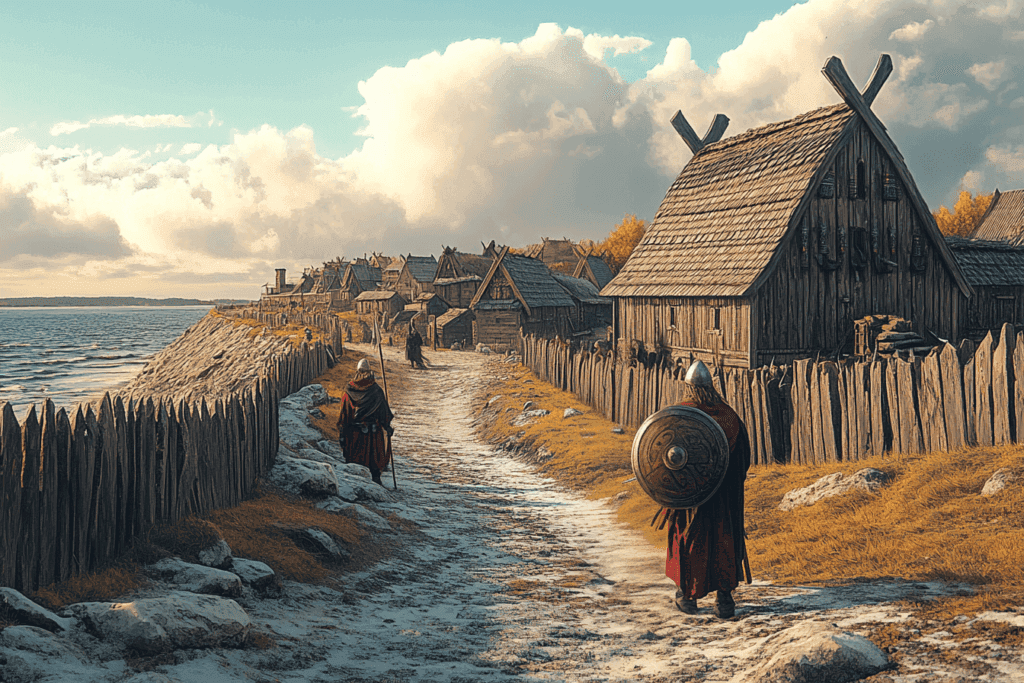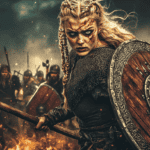
The Jomsvikings, a legendary order of Viking mercenaries, have captivated historians and enthusiasts alike for centuries. Renowned for their discipline, loyalty, and martial prowess, they were a unique force in the Viking Age, blending myth and history into an enduring legacy.
Origins of the Jomsvikings

The origins of the Jomsvikings are shrouded in both historical accounts and saga traditions. Their stronghold, Jomsborg, is believed to have been located on the southern Baltic coast, near present-day Wolin in Poland. However, its exact location remains a topic of scholarly debate. According to the Jómsvíkinga saga, Jomsborg was founded by Palnatoke, a Viking leader who received land from the mythical Wendish ruler Burislav. Other sources attribute its foundation to King Harald Bluetooth of Denmark, who is said to have established it as a military outpost to secure trade routes and protect his interests in the Baltic region.
Regardless of its founder, Jomsborg became a hub for a unique warrior brotherhood. The Jomsvikings were not a typical Viking raiding party; they were an elite group with strict membership criteria and a rigid code of conduct. Their exclusivity and discipline set them apart from other Viking bands.
The Code of the Jomsvikings
The Jomsvikings adhered to a strict warrior code that governed their behavior both on and off the battlefield. Membership was limited to men aged 18 to 50 who demonstrated exceptional physical and psychological strength. Prospective members had to prove their worth through trials, including duels known as holmgangs, where they fought existing members to earn their place.
Key aspects of their code included:
- Loyalty and Brotherhood: Members were required to avenge each other as if they were blood relatives.
- Discipline: Gossiping was prohibited, and members could not leave the fortress for more than three nights without permission.
- Equality: Spoils of war were divided equally among all members.
- Exclusivity: Women were not allowed in their fortress, emphasizing their focus on camaraderie and focussed martial excellence.
This code fostered a sense of unity and discipline that made the Jomsvikings formidable opponents in battle.
Military Prowess and Campaigns

The Jomsvikings were renowned for their exceptional combat skills, particularly at sea. Masters of Viking longships, they could execute swift raids or engage in large-scale naval battles with equal efficiency. Their reputation as fearless warriors earned them roles as mercenaries for various rulers across Scandinavia and beyond.
There are a number of battles that the Jomsvikings played a significant role in; however, it is a reflection of the warriors’ semi-legendary nature that their defeats in two of them is put down to divine intervention!
Battle of Fýrisvellir (c. 984)
The Jomsvikings fought alongside Styrbjörn the Strong, an exiled Swedish prince, in his attempt to seize the Swedish throne from his uncle, King Eric the Victorious. The battle took place on the plains of Fýrisvellir near Uppsala. Despite their ferocity, Styrbjörn’s forces suffered a devastating defeat, attributed to King Eric’s alleged pact with Odin. This battle is commemorated on several runestones and in skaldic poetry.
Battle of Hjörungavágr (986)
This naval battle occurred when the Jomsvikings launched an attack on Haakon Sigurdsson, the Jarl of Norway. Led by Sigvald Jarl, the Jomsvikings initially inflicted heavy losses on Haakon’s forces. However, Haakon reportedly invoked divine intervention from Thorgerd Holgabrudr and Irpa, mythical goddesses, turning the tide of battle. The Jomsvikings were ultimately defeated, and many were captured and executed, though some displayed such bravery that they were spared.
Battle of Svolder (1000)
The Jomsvikings fought with distinction in this pivotal naval battle, siding with Denmark and Sweden against King Olaf Tryggvason of Norway. The battle ended in Olaf’s dramatic defeat and death, solidifying Danish dominance in Scandinavia and marking the end of Olaf Tryggvason’s reign and his attempts to unify Norway under Christian rule. The Jomsvikings’ contribution to this victory further cemented their reputation as elite warriors.
Raids on England (1010–1012)
Under Thorkell the Tall’s leadership, a contingent of Jomsvikings participated in extensive raids across southern England. The Vikings targeted East Anglia early in their campaign, sacking Thetford and defeating the East Anglian army in battle, enabling them to plunder the region unhindered. The following year Canterbury, one of England’s most important religious centers, fell to the Vikings who captured Archbishop Ælfheah. Despite being offered ransom for his release, Ælfheah refused to allow his people to pay it. This defiance enraged his captors, who executed him in 1012 by pelting him with bones and cattle heads before delivering a fatal blow with an axe.
Despite their initial role as raiders, some Jomsvikings switched sides during this period. In 1012, part of Thorkell’s band entered into the Saxon King Æthelred’s service as mercenaries, reflecting their allegiance to no Norse kingdom, just to their fellow Jomsvikings. However, this alliance proved short-lived. When Sweyn Forkbeard invaded England later in 1013, Thorkell and his remaining forces abandoned Æthelred and joined Sweyn’s campaign, further destabilising England and paving the way for Sweyn’s victory and brief reign as king.
Cultural Significance
The Jomsvikings occupy a unique place in Nordic mythology and history. Their disciplined lifestyle and warrior ethos have drawn comparisons to medieval knightly orders like the Templars. They were staunch followers of Old Norse deities such as Odin and Thor but were pragmatic enough to fight for Christian rulers (like the English king Æthelred) if adequately compensated.
Their exploits are immortalized in Icelandic sagas like the Jómsvíkinga saga and King Olaf Tryggvasson’s Saga. These texts blend historical events with legendary embellishments, making it challenging to separate fact from fiction. Nevertheless, they provide valuable insights into Viking culture and values during the late Viking Age.
Decline and Legacy

The decline of the Jomsvikings coincided with broader changes in Scandinavian society. As centralized kingdoms grew stronger during the 11th century, independent warrior bands like the Jomsvikings found it increasingly difficult to operate.
The Jomsvikings’ willingness to fight for various rulers may have spread them too thin, leading to losses that weakened their cohesion as an elite force. Their downfall came about in 1043 when, according to Heimskringla, King Magnus I of Norway destroyed Jomsborg while consolidating his rule over Denmark. This marked the end of their stronghold as a power center.
Despite their demise, the legend of the Jomsvikings endures. They remain symbols of Viking martial prowess and discipline, inspiring modern interpretations in literature, games, and popular culture.




